Cucumber leaves turning yellow usually means one thing:
A sickly plant in need of attention.
In this guide, I’ll show you how to identify the cause and what you can do about it.
Let’s dive in.
What Is Happening?
The loss of the green coloration of the leaves, caused by a lack of chlorophyll, is known as chlorosis.
As chlorophyll is essential for converting sunlight into chemical energy, its reduction threatens the health of your cucumber plant.
But to find out exactly what’s causing it you need to take a closer look.
Cucumber Leaves Turning Yellow: The Causes
The causes of chlorosis usually fall into one of 6 categories: plant pests, diseases, nutritional deficiencies, light problems, natural aging, and water problems.
Let’s take a closer look at how you can identify your problem, and importantly, what you can do about it:
Plant Pests
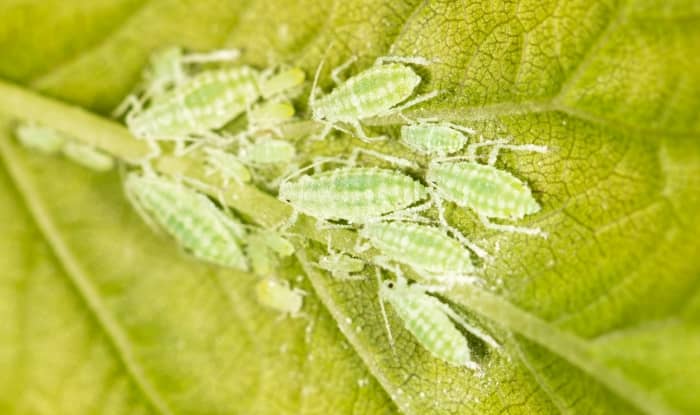
Aphids (Aphidoidea) on a leaf
You’ve probably come across a variety of different insects on your plants. But did you know that some of them suck the sap out of the leaves?
This is a common cause of leaf discoloration and can cause them to turn yellow.
These are some of the most common:
Aphids – these small oval-shaped insects hang out on the underside of leaves. They are often green or yellow and leave behind a sticky black substance called honeydew.
Spider Mites – suck on the cucumber leaves causing yellow stippling. They are another insect that’s usually found on leaf undersides where they leave behind a silvery, fine webbing.
Whiteflies – if you shake the leaves and see a cloud of tiny, white winged insects rise up, then your plant is infested with whiteflies. Like aphids, they also leave behind honeydew.
You can spray insecticidal soap on the leaves of the plant to get rid of these unwanted bugs.
The Potato Leafhopper

Potato Leafhopper (Empoasca fabae) Source: gailhampshire
These are bigger than the pests mentioned above, but they also enjoy feeding on your plants by sucking the sap from the leaves.
While feeding, they inject a toxin that causes yellowing. And as the damage accumulates, the leaves sometimes develop white specks and eventually fall from the plant.
You can use insecticides to kill potato leafhoppers. But for obvious reasons, that’s not always desirable on plants that you’re using for food.
So another method is to keep the area free from weeds and use row covers over the plants to keep the insects away.
Plant Diseases
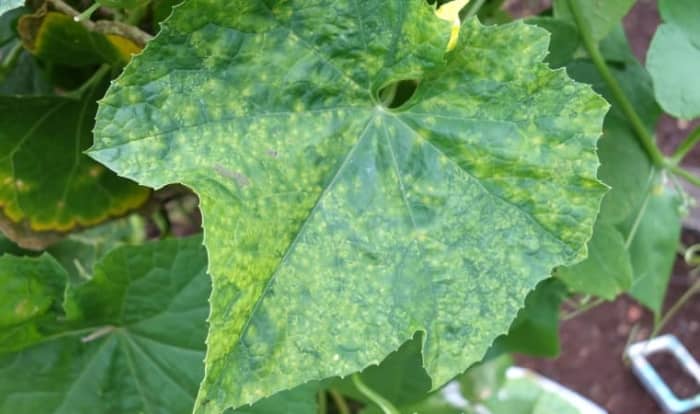
Cucumber mosaic virus
Diseases are often responsible for the appearance of yellow spots or streaks on cucumber leaves.
Check to see if your plants are infected with any of these:
Cucumber Mosaic Virus
Are the leaves wrinkled and downward-curving with yellow spots?
Then they might be infected by cucumber mosaic virus.
Unfortunately, the only solution to this problem is to remove the infected plants because there’s no treatment available. If left, the disease will often spread as it’s carried by aphids and leafhoppers.
Be aware that it can live in the soil and infect new plants the following year.
The same also applies to our next disease…
Fusarium Wilt
Take a close look at the older leaves. Are they turning yellow, starting from the edges and spreading inwards?
Cucumber beetle larvae are responsible for the spread of this disease as they feed on the plant’s roots.
Similar to the mosaic virus, the only way to deal with it is to get rid of the infected plants. There are a number of options for cultural and biological control of this fungus.
Another similar fungus is Verticillium wilt. This is common if your cucumber plants are planted in an area that was previously used for vegetables such as peppers, tomatoes, potatoes, or eggplants.
Downy Mildew
The telltale signs of downy mildew are yellow spots on the upper surface of the leaves which turn to brown later on.
These spots are angularly bounded by veins in the leaves, giving an almost patchwork appearance.
And in high humidity, a grey fuzz can be found on the underside of the leaves.
To prevent and manage the disease there are several options:
- Planting cucumber varieties that have a high level of resistance.
- Improve air circulation around the cucumber plants and keep leaves dry by using wide row spacing and drip irrigation.
- Remove infected plants immediately to prevent spread.
- Contact and systemic fungicides are available that are effective against downy mildew when applied early in the disease progression.
Nutritional Deficiency
Cucumbers need a number of different nutrients to grow properly, and if these are lacking chlorosis can occur.
To accurately assess whether your plant is lacking in specific nutrients it’s a good idea to have the soil in your vegetable garden tested.
The following are the most common deficiencies that can result in your cucumber plant leaves turning yellow:
Nitrogen Deficiency
Not only will nitrogen deficiency turn cuke leaves yellow, but it also stunts their growth. With the plant eventually dying if the situation is severe.
Look out for the older leaves on the plant starting to pale along the central veins and at the tips. With newer leaves continuing to look green.
Fortunately, this problem is also very easy to fix. You can increase the nitrogen content of the soil by adding a 2-inch layer of compost.
Or, you can add 1-2 tablespoons of 6-10-10 fertilizer if you notice a problem.
Another thing you can do is use a tablespoon of ammonium nitrate when you see the flowers of the plant start to bloom. Add it to the soil again 3 weeks later.
But, be careful not to put too much fertilizer in the soil as it will prevent the plant from producing its fruit, the cucumbers themselves!
Iron Deficiency
If new leaves are yellow with green veins, but the older leaves are still green, then iron deficiency is a possible cause.
To treat this deficiency you can add granular or powdered chelated iron to the soil around the root zone. Or you can spray liquid iron on the plant.
Potassium Deficiency
Cucumbers have a high potassium requirement and are one of the only crops that need more potassium than nitrogen
The symptoms of potassium deficiency are leaves that turn yellow at their tips and edges. Young leaves tend to be small, dull looking, and cupped or puckered. The cucumber fruit often have a club-shaped appearance due to being narrow close to the stem.
Using a well-balanced fertilizer on your cucumber plants can solve this issue. And treat the soil for acidity or alkalinity if needed.
Zinc Deficiency
To identify cucumber plants suffering from a zinc deficiency, look for older leaves turning yellow between the vein. Leaf size is usually small and growth of the plant is restricted.
Spraying with a zinc sulfate solution is an easy way to correct this problem. You can also use organic kelp.
Water Related Yellowing
Be careful not to overwater your cukes. Including rainfall, cucumber plants only need about 1-2 inches of water each week.
While cucumbers require an adequate water supply for healthy growth, excessive watering can lead to several problems:
Root Rot
Overwatering can saturate the soil, causing the roots to become waterlogged and deprived of oxygen. This can lead to root rot, where the roots decay and can no longer absorb nutrients effectively. Symptoms include the leaves turning yellow and wilting, and stunted growth.
Poor Nutrient Uptake
If the soil is waterlogged, the roots may struggle to take up nutrients properly. This can result in nutrient deficiencies and negatively impact the plant’s overall health and productivity.
Fungal Disease
Excessive moisture creates favorable conditions for fungal diseases, such as powdery mildew or downy mildew. These diseases cause leaf discoloration, fungal growth, and plant decline.
To avoid these problems, maintain a balance in watering. Here are some general guidelines:
Water Deeply But Infrequently
Give your cucumber plants a thorough watering, allowing the water to penetrate the soil deeply. However, wait until the top inch or so of the soil feels slightly dry before watering again. This helps promote healthy root growth and prevents waterlogged conditions.
Use Well-draining Soil
Ensure that the soil in which you plant your cucumbers has good drainage. Amending heavy clay soils with organic matter, such as compost, can improve drainage.
Mulch The Soil
Applying a layer of organic mulch, such as straw or wood chips, around the base of the cucumber plants can help retain moisture in the soil while preventing excessive evaporation. Mulching also helps regulate soil temperature and suppress weed growth.
Monitor Plant Needs
Keep an eye on the cucumber plants and observe any signs of water stress or overwatering. Adjust your watering schedule accordingly, considering the specific needs of your plants and the environmental conditions.
Remember that different factors, such as climate, soil type, and plant size, can affect the watering requirements of cucumber plants.
If your soil has drainage problems, consider loosening it with sand. Another solution is to grow your cukes in raised beds instead. Or containers with large drainage holes.
Lack Of Sunlight
Sometimes, the reason for yellow droopy leaves on your cucumber plant is simply that it’s not getting enough sunlight. Try moving them to a location in your garden where they can get at least 6 hours per day.
Natural Aging
Cucumber leaves naturally turn yellow and die as they age. If the older leaves are yellow, but the new leaves are healthy and green, then it’s likely just a natural process. If you want to, you can remove the old leaves to tidy up the plant, but it’s unnecessary for its health.
FAQ
Should I Cut Off Yellow Cucumber Leaves?
The decision to cut off yellowing leaves depends on the cause. If the cucumber leaves are turning yellow because of the natural aging process or a cosmetic issue, removing them is optional. But, if it’s due to nutrient deficiencies, diseases, pests, or root problems, addressing the underlying cause and removing the affected leaves can benefit plant health.
Featured image source: Cristina Sanvito

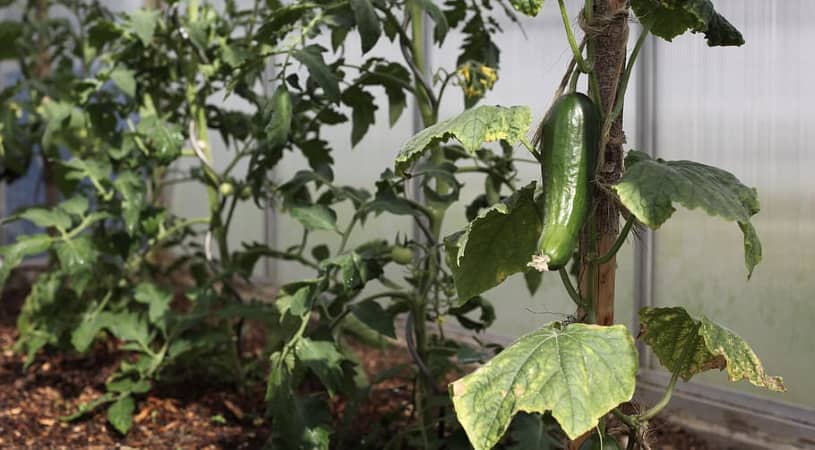
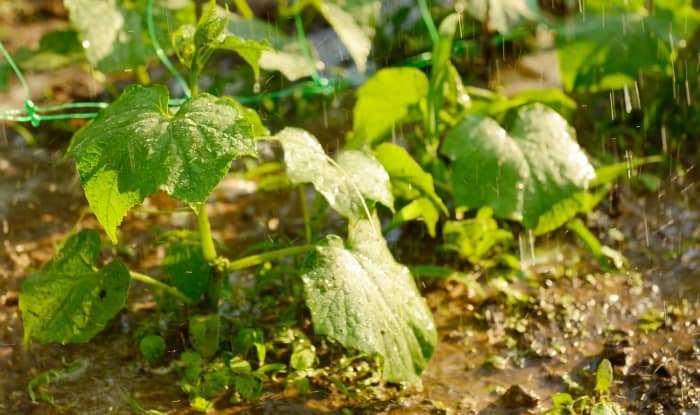
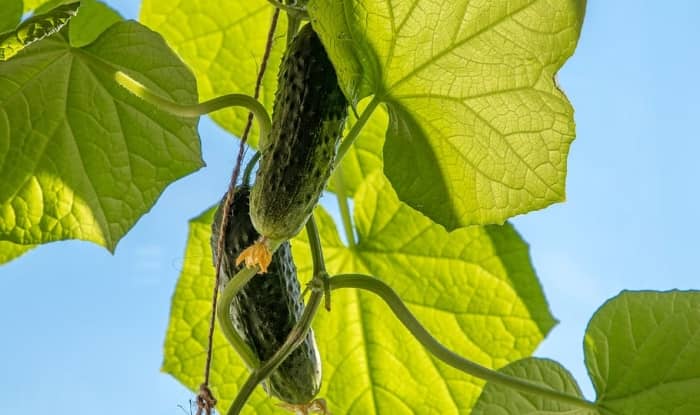
Six out of my nine cucumber plants have wilted with leaves gone yellow. I have been watering them daily with a little water and on one occasion I added tomato fertiliser liquid to the water. I have stopped watering for the last four days but none of the plants have recovered. The three that are OK seem to be thriving yet received the same treatment. The plants are in the greenhouse which has been extremely hot the last few days. I know now that I have over watered the plants but has the tomato fertiliser and hot greenhouse conditions had and impact as well.
This is happening to me.
Did you find a solution?
For the yellowing of leaves,try and use epsom salt for them
Hello fellow gardener. I read your comment because my cukes are getting the burn spots on them and I used a solution of 3 tbsp Epsom salt to a 2 gal sprayer. Tomatoe plants are doing good but know my cukes and zucchini is a different story. I bought 2 different types of soil test kits to see what’s going on there.
I have been reading for years and trying to have a garden every year, but none have gotten as beautiful as it was/is this year. I also read that to build up the plants immune system, dissolve 6 aspirin in a gallon of water and spray the leaves. This is “suppose to Kickstart the plants immune system to fight off disease”. Have you ever tried that?
exactly the same with me i use tomato fertilizer once a week and water every day. I have fruit but leaves now yellow mottled and pale
Try spray with a mixture of 2 to 3 teaspoons of plain Epsom Salt to 1/2 gallon of water. Also, immune booster 6 aspirin dissolved into a 1 gallon spray. It absorbs into the plant and; supposedly, aspirin Kickstart the immune system of the plant to assist in healing it and making it stronger.
I had to do those 2 things and remove ALL damaged leaves from the plants and stake them up and I made a conduit over the top and I strung up my tomatoes. The problem is that when the air can’t circulate the fruits can’t get air then comes disease. I purchased a Rapitest Digital soil test kit and a Sankar 3 in 1 Soil Moisture/Light/ph tester.
It has taken a long time for me to grow anything.
I thought I was being a “good” gardener by watering my garden daily, due to the extreme heat we have been having. Guess I was wrong! Purchased some items at Lowes that might help. Compost with mushroom sand some good rich potting soil. I’ll add that to my cucumbers and also add Epson salt to it’s diet. I’ll water perhaps every other day, Would using a sun shade cloth help out the plants. Will appreciate any advise to save my garden.